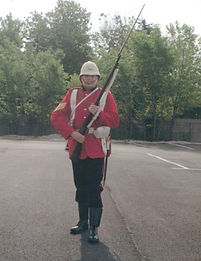
Coldstream Guards Living History Museum
Keeping The Dream Alive
The Victorian Age
The 1st Battalion embarked for the Crimea in 1854 and played an important part in the Battles of Alma, Inkerman and Sevastopol. The Treaty of Paris brought peace on March 1856 and the 1st Battalion returned to England in June of that year. Four Coldstreamers - Brevet Majors Goodlake and Conolly and Privates Strong and Stanlake- received the Victoria Cross (which had been instituted in early 1856) on their return.



Sergeant William Knapp, 1st.Battalion, Coldstream Guards in Aldershot, Hampshire - July 1856.
He is wearing the Crimea Medal with four bars for Alma, Balaklava, Inkermann and Sebastopol
- photograph by Robert Howlett and Joseph Cundall.
Coldstream Guardsmen Nunn, Potter and Deal in Aldershot for a London victory parade in July 1856 (photograph by Robert Howlett and Joseph Cundall).
They all wear the Crimea Medal with four bars for Alma, Balaklava, Inkermann and Sebastopol. (IWM Q 71095)
Colour Sergeant Absolam Durrant, 1st. Battalion, Coldstream Guards in Aldershot, Hampshire - July 1856. (Photograph by Robert Howlett and Joseph Cundall)

Major Klapmeier, Sgt. Augle and Guardsman Smith
Boscobel, WI 2009
Foreign Observers
From 1856 to 1882, the Regiment enjoyed a long period of peace. However, in August 1882, the 2nd Battalion embarked from Ireland to join the Guards Brigade for service in Egypt against the rebels under Arabi Pashi. The Brigade consisted of the 2nd Battalion Grenadier Guards and the 1st Battalion Scots Guards, commanded by Major General HRH the Duke of Connaught, KG. The arrival of the 2nd Battalion Coldstream Guards completed the Brigade. The campaign ended after the Battle of Tel-el-Kebir and the 2nd Battalion returned home.

Sgt. Mayhugh, at the Parade in Geneva, IL for Memorial Day. Coldstream Guards in Egypt 1882.
Weapon: Martini Henry MkIV
Kit: 1882 Valise
Uniform: Pattern 1881 Tunic with dress blue tweeds
Early in 1885, the 1st Battalion embarked for the Suakin Campaign and took part in the actions at Haskin and at Tofrek, returning home in September. From 1885 to 1897, the Regiment was once more left undisturbed by operations or administrative change. In 1897, Parliament sanctioned the addition of a 3rd Battalion to the Regiment. HM Queen Victoria presented New Colours to the new Battalion at Aldershot in July 1898. In 1899, on the outbreak of the Boer War, the 2nd Battalion left for South Africa, and the 1st Battalion also embarked from Gibraltar for the same destination. By November, both Battalions had encamped near the Orange River Station and later played a very distinguished part in the campaign that followed. On the conclusion of peace in May 1902, they arrived home together at Aldershot.